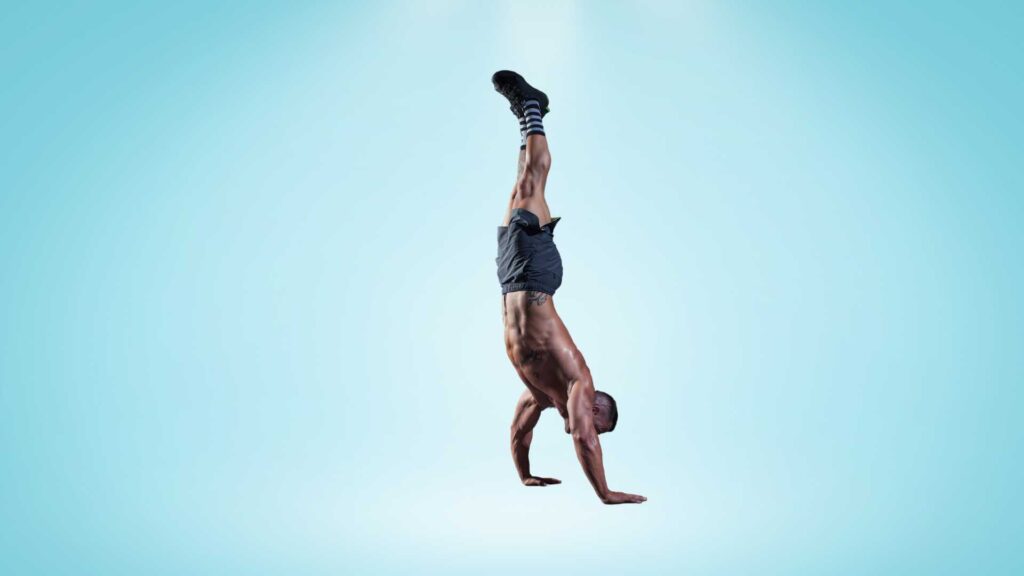Mastering a handstand is an impressive strength, balance, and body control feat. However, for handstand beginners, one of the most common questions is: How long does it take to learn a handstand? While timelines vary significantly based on the individual, understanding the handstand journey can help set realistic expectations.
Table of Contents
What is a handstand?
A handstand balances the entire body vertically while only the hands contact the floor. The fingers spread wide to distribute weight as the palms press down firmly. The arms straighten fully, and the shoulders depress to support the inverted body weight. The core tightens to prevent arching of the back. The legs extend vertically above the hips, either held together or straddled in a split position.
The mechanics and technique of a proper handstand
Learning proper handstand technique is crucial for execution and injury prevention. Key setup steps include shoulder mobility, engaged finger and hand placement, pressed shoulders, wrists, elbows, and shoulders alignment, and an activated core. Common errors involve arching the back, bending arms, and poor shoulder positioning. Mastering the inverted feel and balancing the center of gravity are also essential techniques.
Key muscle groups used in handstands
Handstands utilise the full body but heavily engage the shoulders, arms, core, glutes and quads. The deltoids, triceps, serratus anterior, and rotator cuff muscles stabilise the demanding shoulder positioning. A properly engaged core prevents back hyperextension. Glute activation and quad strength enable balanced leg positioning.
Related: 11 Effective Techniques For Counterbalance Squat
How Long Does It Take To Learn A Handstand
Typical goals include:
- Building shoulder and wrist strength.
- Achieving balance through proper alignment.
- Increasing inverted hold duration.
- Executing a controlled kick-up and descent.
- Reducing reliance on wall support.
- Advancing to more difficult variations like one-arm handstands.
Assessing Your Starting Point
Documenting current ability level
Before setting handstand goals, assess current capabilities like the torso and shoulder flexibility, wrist mobility, balance, and strength levels. Be realistic about your starting point.
Identifying strength imbalances or limitations
Note areas like inflexible shoulders, weak core or wrists, poor balance, etc., that may require targeted supplemental training to prevent injury.
Understanding motivation and managing expectations
Define your motivations, goal timeline, and patience level. Handstands require consistent practice for most. Avoid unrealistic expectations.
Related: Candlesticks Exercise For True Core Strength
The Learning Process Timeline
Initial preparation: stretching, wrist and shoulder mobility
Dedicate time upfront to build flexibility and joint mobility through stretches and warm-ups. It prevents future plateaus.
Wall-supported chest-to-wall handstands
Utilize a wall for support and safety as you learn proper handstand body positioning against the wall to build confidence.
Building shoulder strength and body awareness
Progressively improve capacity to hold shoulders in proper alignment while inverted. Develop feelings and control.
Reducing dependence on the wall over time
Slowly wean off the wall dependency by moving farther away and balancing free from support. Be patient with wobbles.
Kick up progression drills
Practise smooth, controlled kick-ups into the handstand position rather than abrupt movements.
Achieving balance and control of the wall
Develop coordination and skill to balance free from the wall through regular practice.
Advancing with new variations and transitions
Try more dynamic moves like tuck-up transitions, straddle presses, pirouettes or one-handed balancing.
Average Time to Handstand Proficiency
Complete beginners: 8-12 months
With fitness base: 4-8 months
With gymnastics experience: 1-4 months
Highly variable based on the individual
Handstand competency timelines depend heavily on your current level. Those new to fitness may spend 8-12 months progressing through prep, wall support, balance, and kick-up. Athletes or gymnasts can achieve proficiency within 1-4 months. Consistency accelerates skill gains.
Related: How To Hold A Long Handstand
Factors That Influence Handstand Learning
Prior related experience
Previous gymnastics, yoga, dance or arts training shortens the learning curve.
Current strength and flexibility
Adequate shoulder, wrist, and back flexibility and core and upper body strength expedite handstand capability.
Frequency and quality of practice
Daily mindful practice optimizes learning. Simply attempting handstands is not enough. Targeted drills and exercises must be practiced thoughtfully.
Mindset and motivation
Confidence, consistency, patience, and determination are required. Handstands are an impressive feat of mental and physical mastery.
Access to coaching and equipment
Quality instruction prevents poor habits. Supportive equipment like wall space, spotting blocks, and mats improves safety.
Developing a Consistent Handstand Practice
Dedicate regular short practice sessions.
Daily short sessions of 5-15 minutes are ideal for ingraining proper technique versus long infrequent sessions.
Follow structured skill progressio.
Steadily progress through preparation, wall support, kick-ups, chest to the wall, stomach to the wall, balancing, new variations, etc.
Film yourself for review
Video your sessions to check for form errors, imbalance, technique flaws, etc.
Celebrate small victories
Mark progress to maintain motivation, not just end goals. Every step forward counts.
Drills and Exercises to Accelerate Learning
Targeted strength and conditioning drills enhance specific capacities needed for handstand excellence:
Shoulder and wrist strengthening – Improves support needed for handstands.
Wall planks and shoulder taps – Develop shoulder stability and strength.
Heel pulls and toe pulls – Build balance skills and body awareness.
Chest-to-wall negative descents – Controlled lowering improves strength.
Stomach-to-wall handstands – Activates shoulders without fear of falling.
One-legged wall handstands: Isolates balance on each side.
Related: what muscles do handstands work
Training Safely and Effectively
- Warm up and cool down thoroughly.
- Prepare joints and muscles carefully before and after practice.
- Listen to your body.
- Rest at the first sign of pain or overexertion to prevent injury.
- Maintain proper form and alignment.
- Prevent injury and ingrain good habits through proper position.
- Know when to rest and recover.
- Handstands are taxing. Schedule rest days and avoid overtraining.
Troubleshooting Common Problems
Fear and lack of confidence: Use wall support and spotters to overcome fear.
Shoulder or wrist discomfort: Strengthen, stretch, and properly align joints.
Pike position in lower back: Engage the core and not overach the lower back.
Difficulty balancing off the wall: Develop control through chest-to-wall practice first.
Related: Kinematics and joints moments profile during straight arm press to handstand
Additional Tips for Handstand Success
Consistency and patience are key – Daily practice over months is needed for most.
Practice on soft mats for safety – Cushioning prevents impact injuries from falls.
Engage a coach for feedback: External cues refine form and prevent poor habits.
Supplement with bodyweight training – Overall fitness boosts handstand capability.
Improving Your Handstand Practice Over Time
Continually increase hold duration – Work up to 60-second inverted holds.
Work on transitions and new variations – Progress to one-arm, straddle-up, pirouettes.
Maintain motivation through plateaus: Celebrate small achievements along the way.
Celebrate every small victory – Each incremental gain is worthy of acknowledgement.
A Word From Blogzah
Be Patient, Persistent and Playful
Handstands require months to years, depending on your starting point. With a step-by-step foundation through wall support, proper technique, kick-up drills, strength training, and consistency through plateaus, the impressive handstand skill can be achieved safely and confidently over time. Stay patient and persistent in your practice while remembering to enjoy the small victories.
FAQs
Why can’t I hold a handstand?
Common reasons for difficulty holding a handstand include lack of shoulder and core strength, tight shoulders or hamstrings, improper alignment, and not kicking up with enough power.
Don’t get discouraged.
Work on strength building, flexibility, and kick up drills. Use a wall for balance assistance. Get coaching cues if needed.
It takes time and practice to balance upside down.
Which handstand is easiest?
For beginners, a chest-to-wall handstand using a wall for balance assistance is often the easiest way to start practicing the alignment and body positioning.
As you advance, a freestanding handstand is considered less stable but allows for a fuller range of motion.
Other variants like one-arm handstands require much greater strength and skill.
Is handstand a hard skill?
Yes, the handstand is considered an advanced gymnastics and circus skill. It requires strength, flexibility, balance, body awareness, and practice.
Don’t get discouraged if you can’t do one right away – work on core and upper body conditioning and kick up drills before trying to balance the full handstand.
Having a coach or spotted practice can help learn proper form safely.
How long is a handstand healthy?
There are no set guidelines, but aiming for 30 seconds to 1 minute of handstand hold time is a reasonable goal for most healthy adults starting out.
Listen to your body and stop if you feel pain, dizziness or fatigue. Build up hold time gradually over weeks/months of consistent practice.
Handstands longer than 2-3 minutes are typically reserved for elite gymnasts and circus performers.
Can everyone do a handstand?
Most people can learn a basic handstand with practice, but some factors like strength, flexibility, proprioception, and body type can make it easier or harder for certain individuals.
Work within your limits, use spotters if needed, and be patient as you build requisite skills.
Those with medical conditions should consult a doctor before attempting handstands.
Am I too old to do a handstand?
It’s generally not too late to learn as an adult if you have reasonable fitness and mobility. Progress slowly and focus on proper technique to avoid injury.
Scale back expectations on hold time. The core and upper body strength required may be harder to build starting later in life, so give your body adequate rest and recovery. Consult a trainer if needed.
How do you build strength for handstands?
Focus on building shoulder stability, triceps/upper back strength, and core power. Pushups, dips, planks, and inverted rows are great exercises.
Yoga can improve flexibility. Handstand-specific drills like wall walks, kick ups, and partner-assisted holds will help develop strength in the right pattern. Allow adequate rest between training days.
















